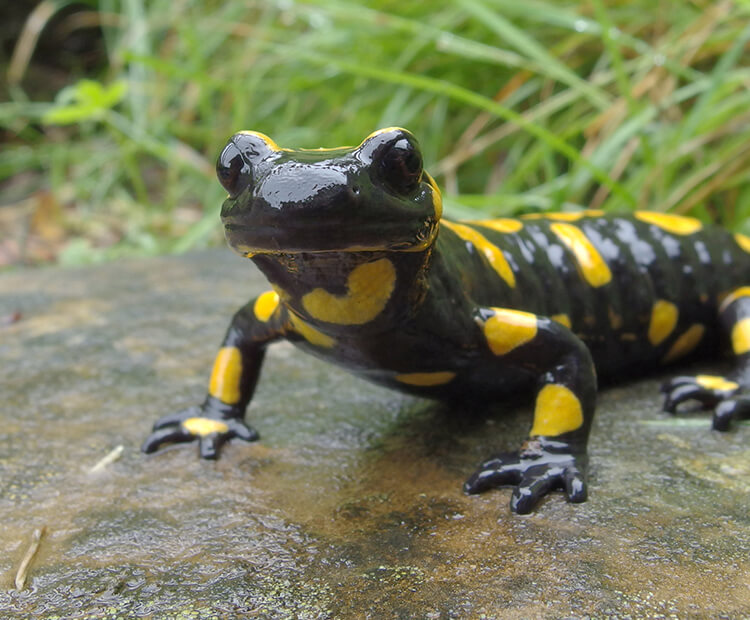Most diverse and hottest terrestrial biome; biome near the equator with warm climate wet weather and lush plant growth
Tropical Rainforest
Which nutrient is not found in the atmosphere?
Phosphorus
Considered limited
Which aquatic biome is the most diverse?
Coral reef
Groups of different species living together in a particular place with a potential for interacting with one another
Community
When energy is passed in an ecosystem from one trophic level to the next, what percent of the energy will pass?
10% Rule

A biome characterized by low moisture levels and infrequent and unpredictable precipitation; daily and seasonal temperatures fluctuate widely; sparse and widely spaced vegetation or no vegetation at all
Desert
Which processes cycle carbon between living organisms and the atmosphere
Photosynthesis
Cellular respiration
Open ocean has photic and aphotic zones. Define what those terms mean.
Photic - sunlight zone (photosynthesis occurs)
Aphotic - No light (organisms have to adapt - chemosynthesis)
Coral and algae are an example of which symbiosis?
Mutualism
Coral provides space/home and CO2 for algae while algae provides nutrients to coral
What is the equation for measuring primary productivity in an ecosystem?
NPP = GPP - RL
NPP - Net Primary Productivity
GPP - Gross Primary Productivity
RL - Respiration Loss
A biome with scattered individual trees, large herbivores, and three distinct seasons based primarily on rainfall; maintained by occasional fires and drought
Temperate Grassland
This cycle involves an element that can be found in sedimentary rocks, volcanic ash, aerosols, and mineral dust
Phosphorus Cycle
Which biome has these ecosystem services: flood control, lowers wave energy, and acts as a nursery for animals?
Estuary - specifically mangroves
Two fire salamanders are fighting over a female for the opportunity to mate. What is the relationship described here?

Intraspecific Competition
If the GPP for a patch of temperate forest is 15 kg C/ m2-year, and the amount of carbon dioxide LEAVING the ecosystem is 5 kg C/ m2-year, what is the NPP?
10 kg C/ m2-year
NPP = GPP - RL
Found along the California coast and the coast of the Mediterranean sea; characterized by hot summers and mild, rainy winters; dominated by fire-tolerant shrubs
Shrubland (Chaparral)
Extraction of fossil fuels and then burning of fossil fuels from cars/factories/etc
What were the human impact for the aquatic biome rivers/streams?
Diversion (ex. dams)
Channeling
Owls and hawks both hunt for field mice. Owls hunt at night and hawks hunt during the day. Describe this interaction.
This would be an example of temporal partitioning
Predict which organisms would have the least amount of energy in this food web.

Muskrat & Osprey
Biome with long, cold winters and small amounts of precipitation; characterized by a northern coniferous forest composed of pine, fir, hemlock, and spruce trees; acidic, mineral-poor topsoils
Taiga "Boreal" Forest
Conversion of gaseous nitrogen (in the atmosphere) to ammonia in the nitrogen cycle
Nitrogen fixation
Which biomes does eutrophication impact? AND what is eutrophication?
Open ocean, Ponds/lakes, estuaries - anywhere where runoff leads to
Eutrophication is an increase in nutrients such as nitrogen and phosphorus causing an algae bloom. When the algae die and decompose it lowers the oxygen level in the water thus killing animals.
What is ocean acidification?
Higher co2 in the atmosphere is dissolved into the ocean. That co2 is converted into carbonic acid which then increases the acidity of the ocean harming organisms such as those with shells.
The net annual primary productivity of a particular estuary ecosystem is found to be 10,000 kcal/m². If respiration by the aquatic producers is 14,000 kcal/m² per year, what is the gross annual primary productivity for this ecosystem, in kcal/m² per year?
24,000 kcal/m² per year
NPP = GPP - RL